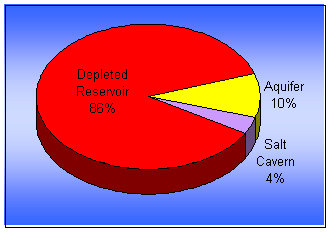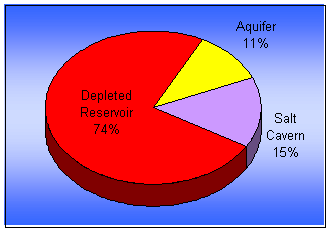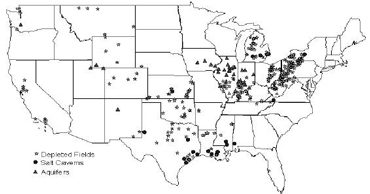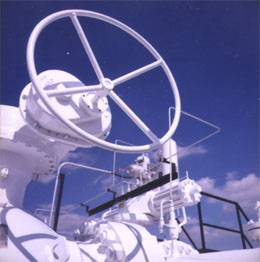Storage of Natural Gas
Natural gas, like most other commodities, can be stored for an indefinite period of time. The exploration, production, and transportation of natural gas takes time, and the natural gas that reaches its destination is not always needed right away, so it is injected into underground storage facilities. These storage facilities can be located near market centers that do not have a ready supply of locally produced natural gas.
Traditionally, natural gas has been a seasonal fuel. That is, demand for natural gas is usually higher during the winter, partly because it is used for heat in residential and commercial settings. Stored natural gas plays a vital role in ensuring that any excess supply delivered during the summer months is available to meet the increased demand of the winter months. However, with the recent trend towards natural gas fired electric generation, demand for natural gas during the summer months is now increasing (due to the demand for electricity to power air conditioners and the like). Natural gas in storage also serves as insurance against any unforeseen accidents, natural disasters, or other occurrences that may affect the production or delivery of natural gas.
Natural gas storage plays a vital role in maintaining the reliability of supply needed to meet the demands of consumers. Historically, when natural gas was a regulated commodity, storage was part of the bundled product sold by the pipelines to distribution utilities. This all changed in 1992 with the introduction of the Federal Energy Regulatory Commission’s (FERC) Order 636, which opened up the natural gas market to deregulation. Essentially, this meant that where natural gas storage was required prior to Order 636 for the operational requirements of the pipelines in meeting the needs of the utilities, it is now available to anyone seeking storage for commercial purposes or operational requirements. Storage used to serve only as a buffer between transportation and distribution, to ensure adequate supplies of natural gas were in place for seasonal demand shifts, and unexpected demand surges. Now, in addition to serving those purposes, natural gas storage is also used by industry participants for commercial reasons; storing gas when prices are low, and withdrawing and selling it when prices are high, for instance. The purpose and use of storage has been closely linked to the regulatory environment of the time. To learn more about the history of regulation and the current regulatory environment, including the effect on natural gas storage, clickhere.
According to the Energy Information Administration (EIA), as of 2000 there was 3.899 Trillion cubic feet (Tcf) of working gas storage capacity in the United States. To learn more about the current uses of storage, including statistics and forecasts relating to natural gas storage, click here.
Base Load vs. Peak Load Storage
There are basically two uses for natural gas in storage facilities: meeting base load requirements, and meeting peak load requirements. As mentioned, natural gas storage is required for two reasons: meeting seasonal demand requirements, and as insurance against unforeseen supply disruptions. Base load storage capacity is used to meet seasonal demand increases. Base load facilities are capable of holding enough natural gas to satisfy long term seasonal demand requirements. Typically, the turn-over rate for natural gas in these facilities is a year; natural gas is generally injected during the summer (non-heating season), which usually runs from April through October, and withdrawn during the winter (heating season), usually from November to March. These reservoirs are larger, but their delivery rates are relatively low, meaning the natural gas that can be extracted each day is limited. Instead, these facilities provide a prolonged, steady supply of natural gas. Depleted gas reservoirs are the most common type of base load storage facility.
Peak load storage facilities, on the other hand, are designed to have high-deliverability for short periods of time, meaning natural gas can be withdrawn from storage quickly should the need arise. Peak load facilities are intended to meet sudden, short-term demand increases. These facilities cannot hold as much natural gas as base load facilities; however, they can deliver smaller amounts of gas more quickly, and can also be replenished in a shorter amount of time than base load facilities. While base load facilities have long term injection and withdrawal seasons, turning over the natural gas in the facility about once per year, peak load facilities can have turn over rates as short as a few days or weeks. Salt caverns are the most common type of peak load storage facility, although aquifers may be used to meet these demands as well.
Natural gas is usually stored underground, in large storage reservoirs. There are three main types of underground storage: depleted gas reservoirs, aquifers, and salt caverns. In addition to underground storage, however, natural gas can be stored as liquefied natural gas (LNG). LNG allows natural gas to be shipped and stored in liquid form, meaning it takes up much less space than gaseous natural gas. To learn more about LNG, click here.
Types of Underground Storage
Underground natural gas storage fields grew in popularity shortly after World War II. At the time, the natural gas industry noted that seasonal demand increases could not feasibly be met by pipeline delivery alone. In order to meet seasonal demand increases, the deliverability of pipelines (and thus their size), would have to increase dramatically. However, the technology required to construct such large pipelines to consuming regions was, at the time, unattainable and unfeasible. In order to be able to meet seasonal demand increases, underground storage fields were the only option.
 |
| Working Gas Capacity by Type of Storage |
| Source: EIA – ‘Natural Gas Storage in the United States in 2001’ |
As mentioned, there are three main types of underground natural gas storage facilities. Specific characteristics of depleted reservoirs, aquifers, and salt caverns may be found below. Essentially, any underground storage facility is reconditioned before injection, to create a sort of storage vessel underground. Natural gas is injected into the formation, building up pressure as more natural gas is added. In this sense, the underground formation becomes a sort of pressurized natural gas container. As with newly drilled wells, the higher the pressure in the storage facility, the more readily gas may be extracted. Once the pressure drops to below that of the wellhead, there is no pressure differential left to push the natural gas out of the storage facility. This means that, in any underground storage facility, there is a certain amount of gas that may never be extracted. This is known as physically unrecoverable gas; it is permanently embedded in the formation.
 |
| Daily Deliverability by Type of Storage |
| Source: EIA – ‘Natural Gas Storage in the United States in 2001’ |
In addition to this physically unrecoverable gas, underground storage facilities contain what is known as ‘base gas’ or ‘cushion gas’. This is the volume of gas that must remain in the storage facility to provide the required pressurization to extract the remaining gas. In the normal operation of the storage facility, this cushion gas remains underground; however a portion of it may be extracted using specialized compression equipment at the wellhead.
‘Working gas’ is the volume of natural gas in the storage reservoir that can be extracted during the normal operation of the storage facility. This is the natural gas that is being stored and withdrawn; the capacity of storage facilities normally refers to their working gas capacity. At the beginning of a withdrawal cycle, the pressure inside the storage facility is at its highest; meaning working gas can be withdrawn at a high rate. As the volume of gas inside the storage facility drops, pressure (and thus deliverability) in the storage facility also decreases. Periodically, underground storage facility operators may reclassify portions of working gas as base gas after evaluating the operation of their facilities.
The graphs shown indicate the working gas capacity and deliverability of natural gas storage facilities in the U.S. as of 2001. It can be seen that depleted reservoirs constitute the majority of working gas capacity and deliverability. However, the high deliverability of salt caverns is shown by the high daily deliverability relative to working gas capacity.
The first instance of natural gas successfully being stored underground occurred in Weland County, Ontario, Canada, in 1915. This storage facility used a depleted natural gas well that had been reconditioned into a storage field. In the United States, the first storage facility was developed just south of Buffalo, New York. By 1930, there were nine storage facilities in six different states. Prior to 1950, virtually all natural gas storage facilities were in depleted reservoirs.
The most prominent and common form of underground storage consists of depleted gas reservoirs. Depleted reservoirs are those formations that have already been tapped of all their recoverable natural gas. This leaves an underground formation, geologically capable of holding natural gas. In addition, using an already developed reservoir for storage purposes allows the use of the extraction and distribution equipment left over from when the field was productive. Having this extraction network in place reduces the cost of converting a depleted reservoir into a storage facility. Depleted reservoirs are also attractive because their geological characteristics are already well known. Of the three types of underground storage, depleted reservoirs, on average, are the cheapest and easiest to develop, operate, and maintain.
The factors that determine whether or not a depleted reservoir will make a suitable storage facility are both geographic and geologic. Geographically, depleted reservoirs must be relatively close to consuming regions. They must also be close to transportation infrastructure, including trunk pipelines and distribution systems. While depleted reservoirs are numerous in the U.S., they are more abundantly available in producing regions. In regions without depleted reservoirs, like the upper Midwest, one of the other two storage options is required.
Geologically, depleted reservoir formations must have high permeability and porosity. The porosity of the formation determines the amount of natural gas that it may hold, while its permeability determines the rate at which natural gas flows through the formation, which in turn determines the rate of injection and withdrawal of working gas. In certain instances, the formation may be stimulated to increase permeability. For information on well treatment, click here.
In order to maintain pressure in depleted reservoirs, about 50 percent of the natural gas in the formation must be kept as cushion gas. However, depleted reservoirs, having already been filled with natural gas and hydrocarbons, do not require the injection of what will become physically unrecoverable gas; that gas already exists in the formation.
Aquifers are underground porous, permeable rock formations that act as natural water reservoirs. However, in certain situations, these water containing formations may be reconditioned and used as natural gas storage facilities. As they are more expensive to develop than depleted reservoirs, these types of storage facilities are usually used only in areas where there are no nearby depleted reservoirs. Traditionally, these facilities are operated with a single winter withdrawal period, although they may be used to meet peak load requirements as well.
Aquifers are the least desirable and most expensive type of natural gas storage facility for a number of reasons. First, the geological characteristics of aquifer formations are not as thoroughly known, as with depleted reservoirs. A significant amount of time and money goes into discovering the geological characteristics of an aquifer, and determining its suitability as a natural gas storage facility. Seismic testing must be performed, much like is done for the exploration of potential natural gas formations. The area of the formation, the composition and porosity of the formation itself, and the existing formation pressure must all be discovered prior to development of the formation. In addition, the capacity of the reservoir is unknown, and may only be determined once the formation is further developed.
In order to develop a natural aquifer into an effective natural gas storage facility, all of the associated infrastructure must also be developed. This includes installation of wells, extraction equipment, pipelines, dehydration facilities, and possibly compression equipment. Since aquifers are naturally full of water, in some instances powerful injection equipment must be used, to allow sufficient injection pressure to push down the resident water and replace it with natural gas. While natural gas being stored in aquifers has already undergone all of its processing, upon extraction from a water bearing aquifer formation the gas typically requires further dehydration prior to transportation, which requires specialized equipment near the wellhead. Aquifer formations do not have the same natural gas retention capabilities as depleted reservoirs. This means that some of the natural gas that is injected escapes from the formation, and must be gathered and extracted by ‘collector’ wells, specifically designed to pick up gas that may escape from the primary aquifer formation.
In addition to these considerations, aquifer formations typically require a great deal more ‘cushion gas’ than do depleted reservoirs. Since there is no naturally occurring gas in the formation to begin with, a certain amount of natural gas that is injected will ultimately prove physically unrecoverable. In aquifer formations, cushion gas requirements can be as high as 80 percent of the total gas volume. While it is possible to extract cushion gas from depleted reservoirs, doing so from aquifer formations could have negative effects, including formation damage. As such, most of the cushion gas that is injected into any one aquifer formation may remain unrecoverable, even after the storage facility is shut down. Most aquifer storage facilities were developed when the price of natural gas was low, meaning this cushion gas was not very expensive to give up. However, with higher prices, aquifer formations are increasingly expensive to develop.
All of these factors mean that developing an aquifer formation as a storage facility can be time consuming and expensive. In some instances, aquifer development can take 4 years, which is more than twice the time it takes to develop depleted reservoirs as storage facilities. In addition to the increased time and cost of aquifer storage, there are also environmental restrictions to using aquifers as natural gas storage. In the early 1980’s the Environmental Protection Agency (EPA) set certain rules and restrictions on the use of aquifers as natural gas storage facilities. These restrictions are intended to reduce the possibility of fresh water contamination. To learn more about the Underground Injection Control program at the EPA, click here.
Underground salt formations offer another option for natural gas storage. These formations are well suited to natural gas storage in that salt caverns, once formed, allow little injected natural gas to escape from the formation unless specifically extracted. The walls of a salt cavern also have the structural strength of steel, which makes it very resilient against reservoir degradation over the life of the storage facility.
Essentially, salt caverns are formed out of existing salt deposits. These underground salt deposits may exist in two possible forms: salt domes, and salt beds. Salt domes are thick formations created from natural salt deposits that, over time, leach up through overlying sedimentary layers to form large dome-type structures. They can be as large as a mile in diameter, and 30,000 feet in height. Typically, salt domes used for natural gas storage are between 6,000 and 1,500 feet beneath the surface, although in certain circumstances they can come much closer to the surface. Salt beds are shallower, thinner formations. These formations are usually no more than 1,000 feet in height. Because salt beds are wide, thin formations, once a salt cavern is introduced, they are more prone to deterioration, and may also be more expensive to develop than salt domes.
Once a suitable salt dome or salt bed deposit is discovered, and deemed suitable for natural gas storage, it is necessary to develop a ‘salt cavern’ within the formation. Essentially, this consists of using water to dissolve and extract a certain amount of salt from the deposit, leaving a large empty space in the formation. This is done by drilling a well down into the formation, and cycling large amounts of water through the completed well. This water will dissolve some of the salt in the deposit, and be cycled back up the well, leaving a large empty space that the salt used to occupy. This process is known as ‘salt cavern leaching’.
Salt cavern leaching is used to create caverns in both types of salt deposits, and can be quite expensive. However, once created, a salt cavern offers an underground natural gas storage vessel with very high deliverability. In addition, cushion gas requirements are the lowest of all three storage types, with salt caverns only requiring about 33 percent of total gas capacity to be used as cushion gas.
Salt cavern storage facilities are primarily located along the Gulf Coast, as well as in the northern states, and are best suited for peak load storage. Salt caverns are typically much smaller than depleted gas reservoirs and aquifers, in fact underground salt caverns usually take up only one one-hundredth of the acreage taken up by a depleted gas reservoir. As such, salt caverns cannot hold the volume of gas necessary to meet base load storage requirements. However, deliverability from salt caverns is typically much higher than for either aquifers or depleted reservoirs. Therefore natural gas stored in a salt cavern may be more readily (and quickly) withdrawn, and caverns may be replenished with natural gas more quickly than in either of the other types of storage facilities. Moreover, salt caverns can readily begin flowing gas on as little as one hour’s notice, which is useful in emergency situations or during unexpected short term demand surges. Salt caverns may also be replenished more quickly than other types of underground storage facilities.
Location of Natural Gas Storage Facilities
 |
| Underground Storage Facilities in the United States |
| Source: EIA – Form EIA-191, ‘Monthly Underground Storage Report’ |
Storage facilities are most concentrated in the consuming north east region of the country, but can be found nationwide. For a summary of natural gas storage facilities by state, click here to see the EIA’s storage statistics.
To learn more about natural gas storage in general, click here to visit the Gas Technology Institute.
Click here to visit the Energy Information Administration’s website, and view the most recent statistics and forecasts related to natural gas storage.
Click here to learn about the business aspects of natural gas storage, including links to the most recent storage statistics, the number of facilities, and their capacity.
Now that natural gas storage has been discussed, click here to learn about natural gas distribution systems.
